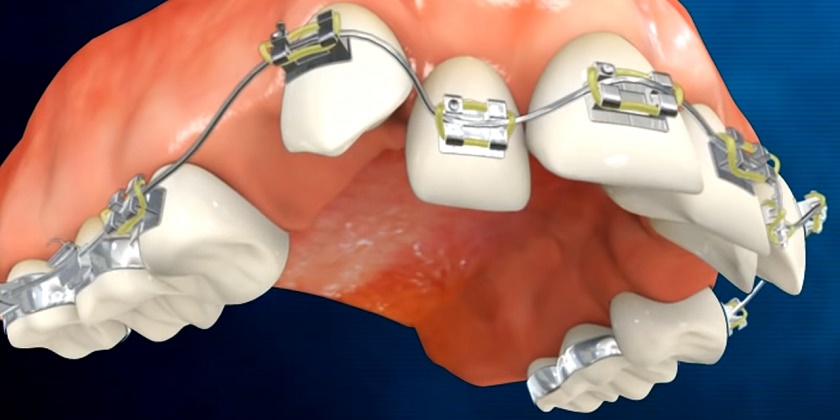- Home
- dental braces fixing

How Do Braces Work?
In their entirety, braces work by applying continuous pressure over a period of time to slowly move teeth in a specific direction. As the teeth move, the bone changes shape as pressure is applied.
Braces are made up of the following components:
- Brackets are the small squares that are bonded directly to the front of each tooth with a special dental bonding agent or are attached to orthodontic bands. Brackets act like handles, holding the arch wires that move the teeth. There are several types of brackets, including stainless steel and tooth-colored ceramic or plastic, which are often selected because they’re less obvious. Occasionally, brackets are cemented to the back of teeth, in order to hide them from view.
- Orthodontic bands are stainless steel, clear, or tooth-colored materials that are cemented to the teeth with dental bonding agents. They wrap around each tooth to provide an anchor for the brackets. The clear or tooth-colored bands are more cosmetically appealing options but are more expensive than stainless steel. They are not used in all patients. Some people have only brackets and no bands.
- Spacers are separators that fit between teeth to create a small space prior to placement of orthodontic bands.
- Arch wires attach to the brackets and act as tracks to guide the movement of the teeth. Arch wires can be made of metal or be clear or tooth-colored.
- Ties are small rubber rings or fine wires that fasten the arch wire to the brackets. They can be clear, metal, or colored.
- A buccal tube on the band of the last tooth holds the end of the arch wire securely in place.
- Tiny elastic rubber bands, called ligatures, hold the arch wires to the brackets.
- Springs may be placed on the arch wires between brackets to push, pull, open, or close the spaces between teeth.
- Two bands on the upper teeth may have headgear tubes on them to hold the facebow of the headgear in place. (A headgear is another tool used by orthodontists to aid in correcting irregularities of the teeth; see below)
- Elastics or rubber bands attach to hooks on brackets and are worn between the upper and lower teeth in various ways. They apply pressure to move the upper teeth against the lower teeth to achieve a perfect fit of individual teeth.
- Facebow headgear is the wire gadget that is used to move the upper molars back in the mouth to correct bite discrepancies and also to create room for crowded teeth. The facebow consists of an inner metal part shaped like a horseshoe that goes in the mouth, attaching to buccal tubes, and an outer part that goes around the outside of the face and is connected to a headgear strap.
- Springs may be placed on the arch wires between brackets to push, pull, open, or close the spaces between teeth.
Newer “mini-braces,” which are much smaller than traditional braces, may be an option for some. There is another method of straightening teeth that uses removable plastic retainers that may also work when crowding of the teeth is not too severe. Your orthodontist will discuss the various types of braces with you and determine which might be the best option for your situation.
How Long Will I Have to Wear Braces?
The time required for braces varies from person to person, depending on the severity of the problem; the amount of room available; the distance the teeth must travel; the health of the teeth, gums, and supporting bone; and how closely the patient follows instructions. On average, however, once the braces are put on, they usually remain in place for one to three years. After braces are removed, most patients will need to wear a retainer all the time for the first six months, then only during sleep for many years.
How Often Will I Need to See the Orthodontist During Treatment?
Your orthodontist will want to see you about every month or so in order to make sure the braces are exerting steady pressure on the teeth. To create more tension and pressure on your teeth, the orthodontist will make adjustments in the wires, springs, or rubber bands of the braces. In some cases, braces alone aren't enough to straighten the teeth or shift the jaw. In these situations, an external appliance, such as headgear, may need to be worn at home in the evening or through the night.
Will Braces Be Painful?
Some of the adjustments your orthodontist may make to your braces may make your mouth feel sore or uncomfortable. When needed, over-the-counter pain relievers like Motrin or Tylenol can help relieve the pain. If you always experience a lot of pain after your braces are adjusted, talk to your orthodontist about it; he or she may be able to make the adjustments a bit differently.
Does the Age Affect the Success of Braces?
The mechanical process used to move teeth with braces is the same at any age. So the benefits of orthodontic treatments are available to both children and adults who wish to improve their appearance and bite. The main differences between treatments in adults and children is that certain corrections in adults may require more than braces alone and the treatments may take longer because adult bones are no longer growing.
Can I Continue to Play Sports While Wearing Braces?
If you have braces, you can continue to participate in any sport you choose. When playing sports where there is a possibility of getting hit in the mouth, a specially designed mouthguard will need to be worn. The mouthguard, made of durable plastic, is designed to fit comfortably over your braces and will protect the soft tissues inside the mouth.
hat Care Can I Expect After the Braces Come Off?
After braces are taken off, your teeth will be thoroughly cleaned. Your orthodontist may want to take another set of X-rays and bite impressions to check how well the braces straightened your teeth and to see if any wisdom teeth have developed. If wisdom teeth are beginning to come in after braces have been removed, your dentist or orthodontist may recommend the wisdom teeth be pulled to prevent newly straightened teeth from shifting.
Your dentist or orthodontist will also fit you with a retainer. A retainer is a custom-made, removable or fixed appliance that helps teeth maintain their new position after braces have been removed. Retainers can also be used to treat minor orthodontic problems. The use of a retainer is a very important part of post-braces care. Retainers, which are typically made of rubber or clear plastic and metal wires that cover the outside surface of the teeth, need to be worn all the time for the first six months and then usually only during sleep. The time frame for wearing a retainer will vary from patient to patient. The reason why a retainer is needed is that even though braces may have successfully straightened your teeth, they are not completely settled in their new position until the bones, gums, and muscles adapt to the change. Also, after long periods of time, teeth tend to shift.

